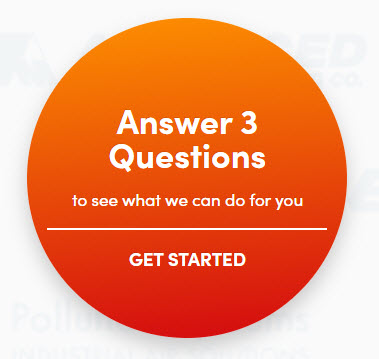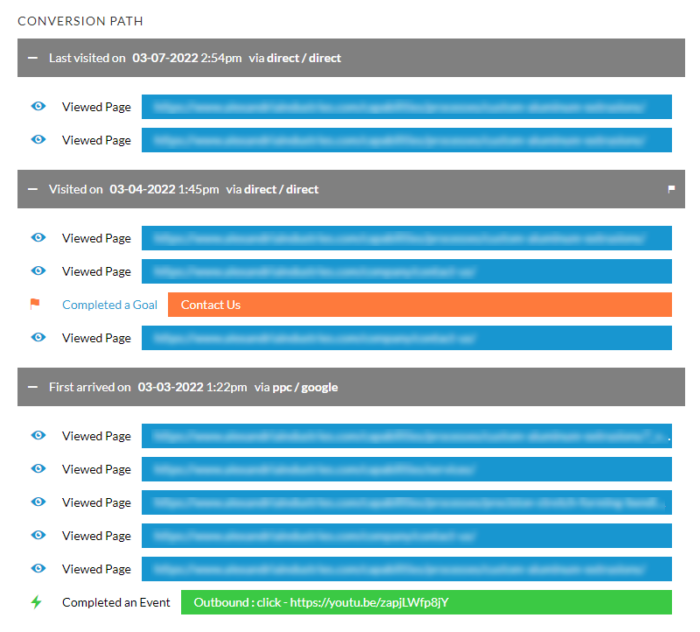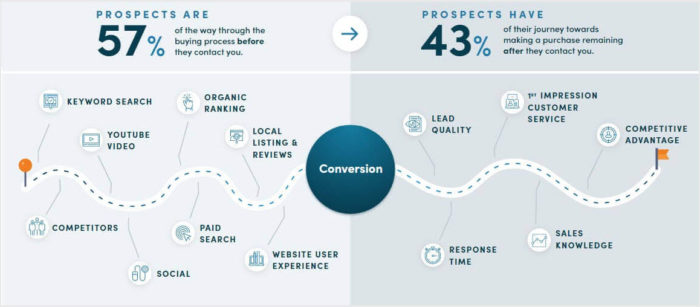July 14 2022
The Journey of Website Conversion
Today we use the internet like we use oxygen, without even thinking. It has become such an involuntary reflex for most of us that we jump on our search engine of choice to get answers for anything, anywhere. It’s so ingrained in our daily lives that it’s difficult to recall a time before a touch of the finger could pull information from outer space down to our device in a split second.
Attracting the Right Audience
Like any new technology, business owners and marketers have taken advantage of this internet magic to get messaging to their target audiences. It all starts with good website design and development. This invaluable piece of internet real estate reflects the entire business, but a customer must be able to find a website for it to have any relevance whatsoever.
Many go to great efforts to drive traffic to their site with Search Engine Optimization, or SEO. SEO is the effort made to ensure your website lands above the fold on the search engine results pages driving organic traffic to a website.
Definition: Above the fold on a website refers to the portion of the site that can be seen on the screen without having to scroll down.
Paid search is another method of gaining website traffic, and it is just as it sounds. Businesses pay to get their brand at the top of search results. These are the ads you see before scrolling down to the organic results of a search (as well as at the bottom of the page). Not only are the efforts intended to increase the number of clicks to a business’ website, but with proper execution, a business should get the attention of a very targeted audience.
Social media also allows a company to grow an audience and get them to its website. Your social pages and your website should meld together like one big branding casserole. No matter which platform someone peruses, they will see consistent branding and be guided to take their desired actions.
The Conversion Journey
Once a website gets the targeted user’s attention, it’s all about engagement, and of course, driving leads from potential customers, also known as “conversion“. Multiple factors determine conversion rate success, but user experience (UX) is arguably the most important. Suffice it to say that if your UX is subpar, your audience will click out as quickly as they clicked in. A well-designed website helps companies gain trust and credibility and allows the customers to better understand the business structure. Ultimately, they will be able to make solid decisions about the products or services.
There are a lot of touchpoints before a user converts. But there are nearly as many after. Keep this in mind as you build your website and digital marketing plans.
When it comes to user experience, there are many parallels between eCommerce sites and brick-and-mortar businesses. We’ve all been in stores that were disheveled, overcrowded, and overwhelming. These stores make the customers work too hard to find products or services. Many times, people don’t even know where to start. No single item catches the eye and nothing directs them where to go. Even the best products become not worth the hassle.
On the contrary, a store that is organized, clean, and has good signage makes for a much more pleasant experience. When business owners consider their websites, they should imagine the customer virtually walking through their store and determine how that journey will appear.
How to Increase Conversions
Many different elements will increase the percentage of conversions, but the two overall factors that help a website convert are content and design. In other words, what you include on your site is as important as how you include it. The designer and the copywriter must work together for these two elements to marry. For example, case studies are very influential when someone is deciding on a purchase, but they must be clearly written, easily accessible, and implemented into a well-planned design.

When landing on a site, a customer should know exactly where you want them to go. You must direct them with Calls-to-Action (CTAs). CTAs are typically buttons or links that give some sort of direction. For example, if you’re selling services online, your CTA may be in button form and say something like “start here” or “sign up now.” It’s okay to get clever with your CTAs, though: just make sure they are clear about what will happen when the user clicks through.
When designing your site, you should think like a user. Are your users more likely to view your site on a PC or a mobile device? Both options should be equally appealing, but a mobile site should allow a customer to take action quicker and easier than the full website. All phone numbers, email addresses, and other contact information should be clickable links that allow someone to reach your company instantaneously.
Results You Can Measure
Google Analytics (GA) gives invaluable feedback on how people interact with websites. It will help determine what is working and what needs to be tweaked. GA can also reveal the number of conversion leads generated on a site and where they started, if set up correctly. Keep in mind, it captures quantity, not quality, so it won’t flag duplicates or spam.

TopSpot’s proprietary form tracking tool, LOOP Analytics, gives even deeper insight into who is coming to your site and what information they want. We also utilize call tracking to gain that additional perspective on what is working and what is not in your sales process.
Multivariate testing should be used to compare the results of two different approaches. This will help answer questions like where shall we place the CTA button, or should we make the description shorter? Businesses should pay close attention and consistently make website content and design decisions accordingly.
What Does This Mean for You?
Your clients are just like you – they are looking for the information that will help them to achieve their goals. Understanding what all goes into the conversion process gives you a solid base for making tweaks and edits to your digital marketing plan. This is a journey, not a destination – you will need to revisit your website consistently and often to keep it at its most effective. For more about conversion optimization possibilities, sign up for our newsletter or contact your Team today!


